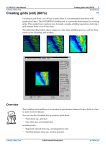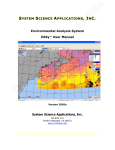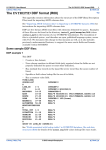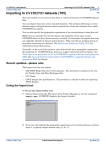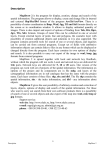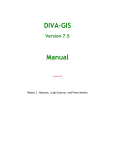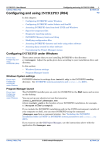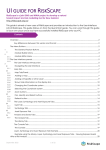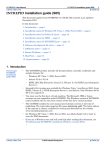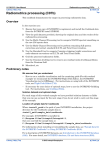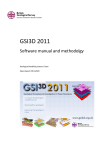Download INTREPID direct access, import and export formats (R11)
Transcript
INTREPID User Manual Library | Help | Top INTREPID direct access, import and export formats (R11) 1 | Back | INTREPID direct access, import and export formats (R11) Top This appendix contain a complete list of file and database formats: • From which INTREPID can import data to an INTREPID dataset OR • Which INTREPID can directly access OR • To which INTREPID can export from INTREPID datasets OR Direct access by INTREPID Access to Geosoft datasets INTREPID can open and save Geosoft vector (.gdb) and grid (.grd) data files (both compressed and uncompressed). To save a dataset in Geosoft format, just specify the required extension .gdb (vector) or .grd (grid) when you specify the output file. INTREPID automatically saves the dataset in the format required. For information about preparing to access Geosoft data, see "Accessing Geosoft files" in INTREPID Installation guide (S05). Notes about Geosoft dataset processing • Uncompressed Geosoft grids do not contain any geolocation data. If you want to include this, import the Geosoft grid to an INTREPID dataset and add the georeference information to the .isi file. Do this by setting Geographic Registration in the Import tool. See "Setting Geographic Registration for vector datasets" in Importing to INTREPID datasets (T05) and "Setting Geographic Registration for a grid dataset" in Importing to INTREPID datasets (T05). • INTREPID supports Geosoft compressed grids. • For vector datasets, INTREPID stores metadata such as statistics and aliases in a .isi file that it automatically adds. The first time you open a .gdb file in INTREPID, INTREPID scans the file and automatically creates the .isi file. If the .gdb file has more than one set of coordinate fields with different datums or projections, you need to select the ones that you want to use. To select a set of coordinate fields, set the X and Y aliases to refer to these fields. Use the Project Manager to edit aliases and select datums and projections. See: Library | Help | Top • "Managing dataset aliases" in INTREPID Project Manager (T02) • "Nominating the datum and projection of a dataset" in INTREPID Project Manager (T02) • You may need to check the tie line convention from Oasis. INTREPID derives from the .gdb file two calculated fields GS_LINE, GS_LINETYPE to act as line number and line type fields for INTREPID tools. • INTREPID does not recognise the Geosoft line selection. If you want INTREPID to ignore a line, change its linetype field value to 9. • INTREPID supports multi-tool use of the same database. Oasis Montaj Viewer write-locks the .gdb. If you want multi-tool access, don’t open it with Oasis Montaj Viewer at that time. • INTREPID automatically allows for the differing sampling rate in .gdb files. • Both INTREPID and Oasis use the POSC underlying specification for datums and projections. © 2012 Intrepid Geophysics | Back | INTREPID User Manual Library | Help | Top INTREPID direct access, import and export formats (R11) 2 | Back | • The Oasis Montaj Viewer driver cannot create or write a new channel with more than 2000 records. The native INTREPID Geosoft driver does not have this limitation. • Once you have nominated your Line, X and Y aliases, you are unlikely to notice any differences between a native INTREPID database and an Oasis database. • We have specified extensions in the Geosoft format to allow for the compound data types (see "Compound data types" in INTREPID database, file and data structures (R05)): • Tensor • Vector (Vector, Component, Gradient) • Observed (Vector, Tensor) Access to ERMapper data INTREPID grid datsets have identical format to ERMapper grids. • ERMapper header (.ers) files can have both upper and lower case text. INTREPID treats these files in a case insensitive manner. • It is our policy with grid datasets to always have grid statistics available. INTREPID will therefore add statistics to ERMapper header (.ers) files unless you specify otherwise. To disable updating of the header file by INTREPID, define the system parameter INTREPID_ERMAPPER_UPDATE (i.e., give it a value). • INTREPID may delete comments (lines starting with #) from the ERMapper header (.ers) file. It will not do this if you have disabled header file updating as described in the preceding paragraph. Generic Mapping Tools (GMT), Data Object Design Studio (DODS), netCDF INTREPID can directly access files and save in Generic Mapping Tools (GMT) netCDF format. You can just open a netCDF (.cdf or .nc) file in an INTREPID tool. To save a dataset in netCDF format, specify the extension .cdf or .nc with the output file name. INTREPID automatically saves the dataset in the format required. ESRI ArcShape files INTREPID can directly access files and save in ESRI ArcShape format. You can just open an ESRI ArcShape (.shp) file in an INTREPID tool. To save a vector dataset in ESRI ArcShape format, specify the extension .shp with the output file name. INTREPID automatically saves the dataset in the format required. Direct access to Oracle databases INTREPID can directly access Oracle and other relational databases for read and write. See Direct access to relational databases (R16) for details. Library | Help | Top © 2012 Intrepid Geophysics | Back | INTREPID User Manual Library | Help | Top INTREPID direct access, import and export formats (R11) 3 | Back | Image formats INTREPID can directly access and write to image formats where this is useful or meaningful. Image formats differ from grid formats as follows: • Images can only contain integer values, with precision sometimes as low as one byte. INTREPID automatically reduces real numbers to integer approximations when writing the data. If an INTREPID tool needs to write real numbers to do its job, such as writing out an FFT-transformed grid, it will not produce image format output. • Image formats contain little or no geo-location metadata. When INTREPID writes in an image format, it creates supplementary metadata files. When it processes or writes to an image file, INTREPID always writes a .isi file containing metadata. INTREPID can access or write to the following image formats: Type Extension Notes Joint Photographic Experts Group (JPEG) .jpg JPEG files contain no geolocation metadata. INTREPID writes a .jpgw file identifying origin and cell size. The .isi file identifies datum and projection Aldus-Adobe's public domain Tagged-Image File Format (TIFF) .tif The TIFF specification contains no georeference information. INTREPID writes a .tifw file that contains cell origin and cell size information. The .isi file identifies datum and projection Georeference or geocoded raster imagery using Aldus-Adobe's public domain Tagged-Image File Format (GeoTIFF) .tif The GeoTIFF specification contains georeference information, including datum and projection. INTREPID writes a .tifw file that also contains the cell origin and cell size information. The .isi file also identifies datum and projection Earth Resource Mapping enhanced compressed wavelet (ECW) .ecw This Earth Resource Mapping open standard compressed image format is only available under Windows. It contains its own geolocation information. Earth Resource Mapping algorithm format .alg This Earth Resource Mapping image rendering language format It contains geolocation information or refers to .ers files Library | Help | Top © 2012 Intrepid Geophysics | Back | INTREPID User Manual Library | Help | Top INTREPID direct access, import and export formats (R11) 4 | Back | Open data access protocol (OpenDAP)—INTREPID JetStream See Open Data Access Protocol and JetStream (R17) for information. AGSO geophysical data tapes INTREPID contains the specifications for fields and precision of data in geophysical data tapes distributed by the Australian Geological Survey Organisation, Geophysical Processing Division. The specification file is in ASCII format and has the name BMRStandardChannels and resides in the directory install_path/config (where install_path is the location of your INTREPID installation). See "Importing AGSO vector data" in Importing to INTREPID datasets (T05) for details. Import and export formats The following table is a summary only of the data formats. For specific instructions about importing data to INTREPID datasets, see Importing to INTREPID datasets (T05). For specific instructions about exporting data from INTREPID datasets, see Exporting from INTREPID datasets (T07). For specific instructions about access to INTREPID datasets by other software packages, see "Accessing INTREPID datasets and tools using other software" in Configuring and using INTREPID (R04) For specific instructions about direct INTREPID access to other data formats, see "Accessing data created by other software" in Configuring and using INTREPID (R04). In the table the I and E columns indicate whether the formats are available for import, direct open, export and direct save. The columns contain notations as follows: Library | Help | Top L imports to a line dataset Pt imports to a point dataset Pg imports to a polygon dataset OV opens as a vector dataset of appropriate type SV INTREPID can directly save vector datasets into this format G imports to a grid dataset OG opens directly as a grid dataset SG INTREPID can directly save grid datasets into this format EX INTREPID can export into this format W Multi-scale edge detection wizard exports in this format © 2012 Intrepid Geophysics | Back | INTREPID User Manual Library | Help | Top INTREPID direct access, import and export formats (R11) 5 | Back | More than one symbol indicates that you have a choice of dataset format or that the dataset type is specified in the import file. Format Description I E AGSO ASCII Argus The ARGUS tape format is a standard for geophysical data exchange developed over many years by AGSO. The ARGUS system has now been replaced by INTREPID, but the tape format is still used. The file BMRStandardChannels in the install_path/config directory contains field specifications for this format. L EX AGSO Binary Argus The Binary Argus format is currently used by AGSO. L AGSO Binary Basos The AGSO Binary Basos format is an old format not currently used by AGSO. L AGSO RAF The AGSO RAF format is a compressed archive format that is usually internal to AGSO. L ASCII Columns ASCII Columns format is for delimited or fixed field length text files. L Pt Pg EX W L OV EX SV W Vector formats For importing, Data Description Format (DDF) files contain field specifications for the import file. See The INTREPID DDF format (R08) for further details. For exporting, export specification files contain field specifications for the resulting export text file. ArcView Shape ECS GPCBASE ECS GPCBASE export files have X, Y coordinates, a line number field and a Z field. INTREPID uses aliases to identify X, Y and line number, and prompts you for the Z field. ASCII XYZ ASCII XYZ is a format for traverse line data. It consists of lines of text (records). The data for a traverse line consists of a header record with the line number, followed by free format X, Y, Z records. The traverse line data is terminated by a blank record. This format is compatible with Geosoft XYZ files. L EX Geosoft GDB Geosoft vector data file. OV L Pt Pg EX SV Geosoft XYZ Geosoft vector data file L Pt Pg EX Geosolutions Geosolutions software .BDB files can be of line type or point type. L Pt EX (L) Library | Help | Top © 2012 Intrepid Geophysics EX | Back | INTREPID User Manual Library | Help | Top Format INTREPID direct access, import and export formats (R11) 6 | Back | Description I gOcad GR_820 E W Radiometric instrument Exploranium GR 820 files have a binary format. INTREPID can import GR 820 binary data blocks into a predetermined vector dataset format. The binary data blocks can be alone in a file or embedded in an ASCII columns file. L If your GR 820 files contain additional information, contact our technical support service for assistance with customising the import process. See "Exploranium GR820 import" in The INTREPID DDF format (R08)for information about importing GR820 data embedded in ASCII columns files. MapInfo MIF EX W Moss Moss is a polygon format often used in government for mining and prospecting lease boundaries. It is similar to Geosoft XYZ format. L NetCDF XYZ NetCDF is a self-describing data format that is suitable for data interchange between unrelated software packages. NetCDF is also sometimes used as a data archiving format. You can obtain information and code for implementing this format from the Internet. OV L Pt Pg SV EX OV SV Oracle databases Picodas Picodas is an aircraft acquisition data system used by contractors. It can be used for radiometric and magnetic data. L SEGY SEGY is a seismic line format used by the petroleum industry. Contact our technical support service for further information about this format if required. L VOXEL Geo VRML EX Virtual Reality Markup Language W Grid (raster) formats AGSO ASCII Grid The AGSO ASCII grid exchange format. G AGSO Binary Grid The AGSO binary grid exchange format. G Library | Help | Top © 2012 Intrepid Geophysics EX | Back | INTREPID User Manual Library | Help | Top INTREPID direct access, import and export formats (R11) 7 | Back | Format Description I E ARC/INFO ARC/INFO and INTREPID grids have the same format. To generate INTREPID header information, import an ARC/INFO grid as a Binary Image. INTREPID can generate an ARC/ INFO header file for any grid dataset so that ARC/INFO can access it. For real (4 byte) data we suggest that you export the data as an ASCII image, then import to ARC/INFO. See "ArcView, MapInfo and ERMapper access to datasets— INTREPIDlynx" in Configuring and using INTREPID (R04)for instructions. G OG SG ASCII Image An ASCII Image file consists of a sequence of numbers in ASCII text (optionally separated by spaces). Each number represents the value of a cell of the grid. Grids exported to this format can be imported as ASCII grids to ARC/INFO. G EX ASCII ImageXYZ ASCII Image XYZ format has X, Y and Z values for each cell of the grid. Data is stored in rows from West to East. ASEG GXF ASEG GXF (Geophysics Exchange Format) is a compressed ASCII format with header keywords followed by the data. It originated in Canada and is used for grid interchange between software packages. G EX Binary Image Binary Image format uses a sequence of binary encoded numbers, each value representing a cell of the grid. This format is software-independent and does not use a header file. G EX EX You can import ARC/INFO and ERDAS Imagine byte and integer (2 byte) grids as Binary Images. DODS Distributes Oceanographic Data Systems (.nc files) OG SG Earth Resources Mapping Algorithm See Image formats OG G SG Earth Resources Mapping ECW See Image formats OG G SG ECS GRDUTE ECS GRDUTE is an ASCII file with a header specifying grid origins and cell sizes. The cell data are arranged as 16 x 16 grid blocks. G EX ECS Gridfile ECS Gridfile is a binary format which can contain a number of grids. The origin for ECS Gridfile format is the bottom left point of the grid. G EX Encom Image An Encom Image file is a binary file composed of a header of 240 bytes followed by the grid values in rows from a starting origin at the bottom left corner. G Library | Help | Top © 2012 Intrepid Geophysics | Back | INTREPID User Manual Library | Help | Top INTREPID direct access, import and export formats (R11) 8 | Back | Format Description I E ERDAS IMAGINE (byte and integer (2 byte) grids) ERDAS IMAGINE and INTREPID grids have the same format. To generate INTREPID header information, import an ERDAS IMAGINE grid as a Binary Image. INTREPID can generate an ERDAS IMAGINE header file for any grid dataset so that ERDAS IMAGINE can access it. See "ArcView, MapInfo and ERMapper access to datasets—INTREPIDlynx" in Configuring and using INTREPID (R04) for instructions. OG G SG ERMapper The ERMapper and INTREPID grid formats are identical. INTREPID automatically maintains ERMapper header files with all grid datasets. ERMapper and INTREPID can access each other's grid datasets OG SG Geosoft GRD Geosoft GRD is an Windows grid format. INTREPID can automatically distinguish the MS–DOS format from the GIPSI (UNIX) format (see below). OG G SG OG G EX Geosoft GRD (Integer) GIPSI GRD GIPSI GRD is a UNIX grid format. GIPSI grid files contain binary data with a 512 byte header followed by the grid data. INTREPID can automatically distinguish the Windows format (see above) from the GIPSI (UNIX) format. G EX GEOPAK GEOPAK software data has this format. G EX G EX GXF Geosolutions Image Geosolutions software data has this format. G EX GeoTIFF See Image formats OG G SG JPEG See Image formats OG G SG G EX SG LCT Binary Image NetCDF GRID (GMT) NetCDF is a self-describing data format that is suitable for data interchange between unrelated software packages. NetCDF is also sometimes used as a data archiving format. You can obtain information and code for implementing this format from the Internet. OG TIFF See Image formats OG G USGS Image Zmap Library | Help | Top Zmap is an oil industry standard seismic grid format containing ASCII data. © 2012 Intrepid Geophysics G EX G EX | Back |








